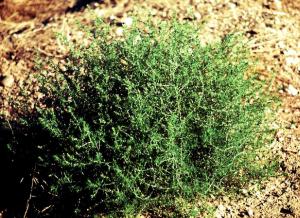CONTENTS
Registered Herbicides
[Return to weed
Identification]
[Return to Weed
Management]
[Home] |
|

General Description:
- well branched, rounded bush grows 1/2 - 3 feet high.
- reddish or purple strips on stems.
- alternate leaves are long and very thin (needle-like).
- small inconspicuous flowers develop in upper leaf
axils - each flower with a pair of spiny bracts.
- acts as a host of the sugar beet leafhopper which
carries a virus that causes curly-top of sugar beets, "blight" of spinach,
tomatoes, and beans.
- mature plants break off at ground level and tumble,
spreading seeds.
Life cycle: annual
- reproduces by seed, single plant may produce 20,000 to
50,000 seeds.
- seeds germinate quickly, even after brief and/or
limited precipitation.
Habitat/ Crops associated with:
- primarily associated with drier regions.
- grows well in dryland cultivation systems \.
- wheat (east of the Cascades), sugarbeets, potatoes,
mint.
- found in overgrazed rangeland, some irrigated crops,
and disturbed waste areas.
Herbicide Control Notes:
- Goal often not adequate, and higher rates might cause
crop injury. Usually emerges too late for effective control with Gramoxone.
|